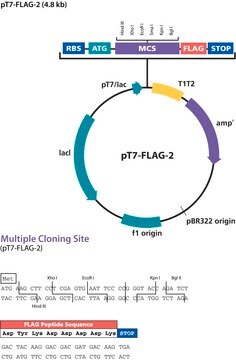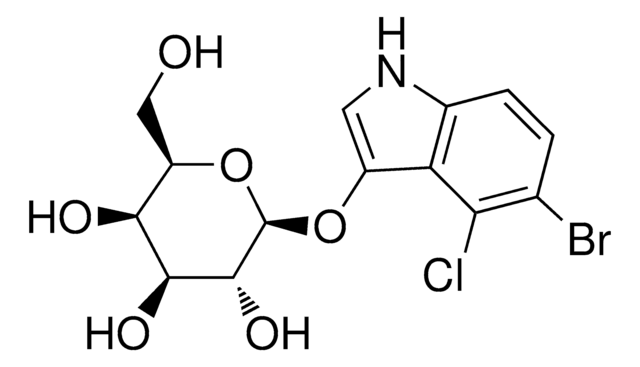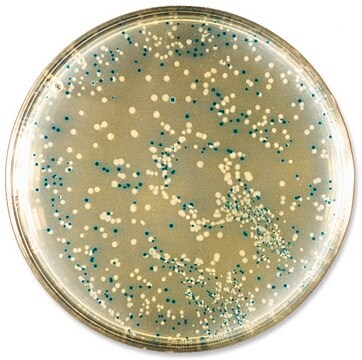PP2393
Mammalian FLAG® Tag Vector Set
plasmid vectors for molecular cloning
Synonim(y):
cloning vector, expression vector, molecular cloning vector, plasmid, plasmid vector, snapfast vector, vector
About This Item
Polecane produkty
znacznik
FLAG® tagged
Postać
buffered aqueous solution
selekcja bakterii
kanamycin
selekcja komórek ssaków
puromycin
Pochodzenie replikacji
pUC (500 copies)
Rozszczepienie peptydów
TEV
no cleavage
Lokalizacja znacznika peptydowego
C-terminal
N-terminal
Promotor
Promoter name: CMV
Promoter activity: constitutive
Promoter type: mammalian
Warunki transportu
ambient
temp. przechowywania
−20°C
Opis ogólny
This pack enables you to compare placing FLAG epitope tags at either the N or C terminus of your gene of interest (inserted into the MCS, under transcriptional control of the CMV promoter) with, and also without a TEV (Tobacco Etch Virus) protease cleavage site. The TEV site enables removal of the FLAG tag from the protein after production. Comparing these four configurations should enable you to evaluate how best to express and detect your gene of interest from mammalian cells. We also provide many other functional tags and cleavage sites, if required.This plasmid set has been designed to be compatible with a range of cloning techniques. The multiple cloning site contains a range of standard commonly used restriction sites for cloning. Using these sites genes can be inserted using standard cloning methods with DNA ligase. Other methods such as ligase independent cloning (LIC) Gibson Assembly InFusionHD or Seamless GeneArt can also be used and because all of our plasmids are based on the same backbone the same method can be used for cloning into all of our catalogue vectors.
Multiple cloning site notes: There are a few important sites within the MCS. These include the NcoI site the XbaI site and the BsgI and BseRI sites. The NcoI site contains a start codon that is immediately downstream of both a Kozak and Shine-Dalgarno ribosomal binding site. These allow for optimal positioning of genes when the start codon is placed in this location. If this is not required and you wish to use a downstream site for gene cloning you can remove the NcoI site by cleaving the plasmid with KpnI. The XbaI site contains a stop codon. This stop codon is positioned in a specific position in relation to the BsgI and BseRI sites that are immediately downstream. When either BseRI or BsgI cleave the plasmid they produce a TA overhang from the stop codon in the XbaI site that is compatible with all of our peptide tag plasmids cut with the same sites. BseRI and BsgI sites are non-palindromic and cleave a defined number of bases away from their binding site. Whenever we clone a gene into our multiple cloning site we always position the start and stop codon in the same positions in the MCS. If the start and ends of the genes are not compatible with NcoI and XbaI we extend the sequence to the nearest external sites but keep the start and stop codons locations consistent.
Transcription Termination: These plasmids contains three alternative transcription terminators for mammalian bacterial and bacteriophage (T7) expression. This means that only the promoter needs to be changed to alter the expression system you are using. We sell multiple promoters that can be used in each of these systems. The presence of each terminator does not reduce expression in the alternative systems.
Sekwencja
Komentarz do analizy
Informacje prawne
Elementy zestawu są też dostępne oddzielnie
- OGS3213PSF-CMV-PURO-NH2-FLAG® - N-TERMINAL FLAG® TAG MAMMALIAN PLASMID, plasmid vector for molecular cloningKarta charakterystyki
- OGS1124PSF-CMV-PURO-COOH-TEV-FLAG® - C-TERMINAL FLAG® TAG MAMMALIAN PLASMID, plasmid vector for molecular cloningKarta charakterystyki
- OGS3423PSF-CMV-PURO-COOH-FLAG® - C-TERMINAL FLAG® TAG MAMMALIAN PLASMID, plasmid vector for molecular cloningKarta charakterystyki
- OGS1123PSF-CMV-PURO-NH2-FLAG®-TEV - N-TERMINAL FLAG® TAG MAMMALIAN PLASMID, plasmid vector for molecular cloningKarta charakterystyki
produkt powiązany
Kod klasy składowania
12 - Non Combustible Liquids
Temperatura zapłonu (°F)
Not applicable
Temperatura zapłonu (°C)
Not applicable
Certyfikaty analizy (CoA)
Poszukaj Certyfikaty analizy (CoA), wpisując numer partii/serii produktów. Numery serii i partii można znaleźć na etykiecie produktu po słowach „seria” lub „partia”.
Masz już ten produkt?
Dokumenty związane z niedawno zakupionymi produktami zostały zamieszczone w Bibliotece dokumentów.
Nasz zespół naukowców ma doświadczenie we wszystkich obszarach badań, w tym w naukach przyrodniczych, materiałoznawstwie, syntezie chemicznej, chromatografii, analityce i wielu innych dziedzinach.
Skontaktuj się z zespołem ds. pomocy technicznej








